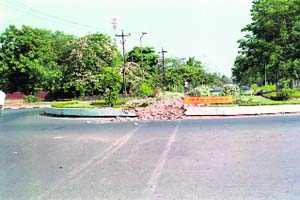|
Good Motoring
Let us make roundabouts safe
H. Kishie Singh 
THE accompanying
photograph shows a roundabout at the crossing of Jan Marg and
Uttar Marg, which was damaged when a speeding vehicle hit
against it. The brake marks were in a straight line, meaning no
evasive action was taken. No attempt to swerve left or right.
The driver was obviously under the influence of liquor. He
relied upon his brakes to stop the car.
These did not
work. The car was travelling too fast. It was badly damaged. So
was part of the roundabout. On braking, the wheels got locked.
No ABS, which may have helped. But the speed and distance
required to stop were not in the driverís favour.
Bashed up rotaries
are a common sight in Chandigarh. It is safe to assume that
rotaries have claimed dozens of lives. In addition, crores of
rupees have been spent on repairs.
Last week there
was a news item which said that "as a solution to the
growing problem (meaning driving into roundabouts), the
administration has now decided to paste a lining of reflectors
on every circle.íí
 "The
experiment has been tried at a couple of roundabouts," says
the administration. Please note, "a couple of
roundabouts," and it is still an experiment. Why not all
the roundabouts where the results would be clear in double quick
time? "The
experiment has been tried at a couple of roundabouts," says
the administration. Please note, "a couple of
roundabouts," and it is still an experiment. Why not all
the roundabouts where the results would be clear in double quick
time?
Here we are in the
21st century, and the administration is still experimenting. In
developed countries, reflective tapes, signs and paints have
been in use since the late 1940s. It was an invention
necessitated by World War II, and immediately after the war, it
was used for civilian purposes. Corporate houses, advertising
agencies, and especially oil companies, saw the huge advantages
of advertising with reflective stickers.
In the 1950s,
American oil companies Caltex and Esso gave you a reflective
bumper sticker if you took on a full tank of petrol. The year
2010 sees the Chandigarh Administration experimenting with a
tried and tested product.
Some years ago, a
proposal was mooted to instal used car tyres on the outer
perimeters of roundabouts. Rubber saves both the roundabout and
the car from extreme damage. It will definitely save lives.
|
Driverís pick
To remove stickers from the glass area, use petrol; then scrape off the remnants of the sticker with a razor blade |
There is no need
to experiment with what used tyres are capable of. F.1
aficionados have witnessed an F.1 car ramming into a tyre wall
at a speed of up to 300 km an hour. The tyres go flying in all
directions. The car suffers considerable damage, and the driver
walks away unscathed. Lesson to be learnt. Used car tyres absorb
impact energy, and are useful for
traffic management.
Used tyres find
use in marinas and harbours as well. As ships and boats come
into load or unload passengers, they scrape against the wooden
or concrete structures of the harbour. To prevent damage either
to the structure or the ships, used tyres are strung up in the
harbour structure. They work. Owners of expensive yachts and F.1
racers have confidence and faith in used tyres. Why does not the
administration?
Doing away with
roundabouts has also been considered as an option. It wonít
help. It will be replaced by traffic lights. During peak hours,
traffic crawls around the roundabouts. At a red light, traffic
is stationary. Elementary, my dear Watson. Crawling traffic is
faster than stationary traffic. What is required are disciplined
drivers who stick to their lanes, do not switch lanes, or try
and overtake at roundabouts. That is a distant dream.
Happy motoring.
|